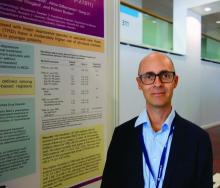PARIS – Young adults with treatment-resistant depression have more than double the risk of all-cause mortality, compared with their peers with major depressive disorder that’s not treatment resistant, Johan Reutfors, MD, PhD, reported at the annual congress of the European College of Neuropsychopharmacology.
Across the full age spectrum of adults with treatment-resistant depression, however, the magnitude of the increased risk associated with treatment-resistant depression is less extreme than in the 18- to 29-year-olds. Yet, the moderate overall 11% increased risk of all-cause mortality in adults with treatment-resistant depression, compared with those with non–treatment-resistant major depressive disorder remains both statistically significant and clinically meaningful, observed Dr. Reutfors, a psychiatrist at the Karolinska Institute in Stockholm.
He presented a cohort study in which he and his coinvestigators utilized comprehensive Swedish national registries to identify 127,087 adults on antidepressant medication for major depressive disorder during 2006-2014. All were under a psychiatrist’s care, and none had a history of bipolar disorder, psychosis, or dementia. A total of 16,329 of them had treatment-resistant depression as defined by lack of improvement on at least two courses of antidepressant therapy of adequate dose and duration.During a mean 4.1 years of follow-up, 4,662 patients died. The all-cause mortality adjusted for age, gender, and a history of substance use disorders or self-harm was 2.17-fold greater in 18- to 29-year-olds who had treatment-resistant depression, compared with those with nonresistant major depressive disorder, 1.51-fold greater in 30- to 49-year-olds with treatment-resistant depression, and 1.18-fold greater in 50- to 69-year-olds with treatment-resistant depression.
In contrast, patients aged 70 or older with treatment-resistant depression had a significant 17% lower risk of all-cause mortality than those with non-TRD major depression. In an interview, Dr. Reutfors said this apparent protective effect was probably tied to survival bias.
“If you have lived so long that perhaps during your lifetime you’ve already had many depressive episodes, maybe only the healthier ones have survived,” he explained.
The all-cause mortality in patients with treatment-resistant depression and a history of self-harm was 37% greater than in patients without treatment-resistant depression.
The causes of excess mortality in the treatment-resistant depression group were quite different in the younger and older patients. In younger patients, the increased mortality was attributed mainly to suicides and accidents. In the older group, where the degree of excess risk was more modest, a variety of fatal illnesses figured more prominently.
The study was supported by Janssen. Dr. Reutfors reported having served as a paid speaker for Eli Lilly and receiving unrestricted grant support from Schering-Plough.


